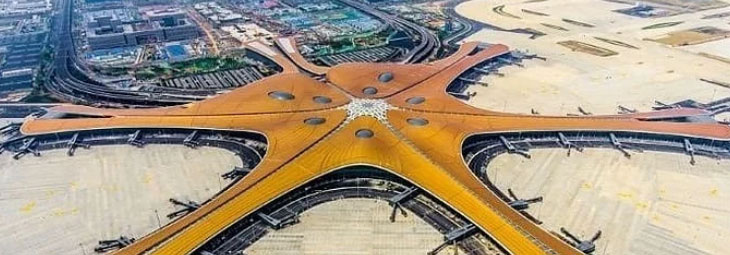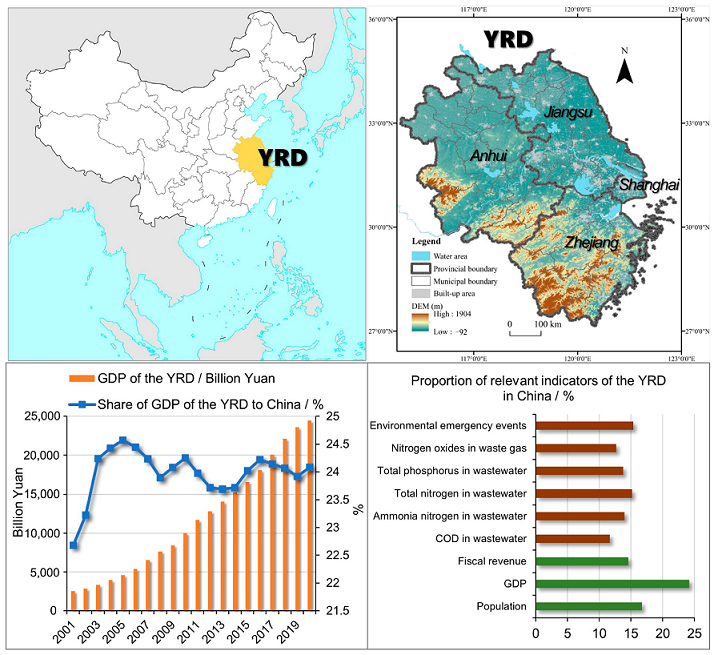

I. Introduction to Yangtze River Delta
The Yangtze River Delta (YRD) is an economic powerhouse of modern China.
The Communist Party of China Central Committee and the State Council jointly issued an outline of the integrated regional development of the Yangtze River Delta on Dec. 2019.
The outline, mapping development for a 358,000-square km expanse that encompasses Jiangsu province, Zhejiang province, Anhui province and Shanghai municipality. The YRD carries 16.74% of China’s population, 24.14% of China’s GDP, and 14.59% of China’s fiscal revenue, with only 3.7% of China’s territory in 2021. The USD 4.28 trillion GDP of the YRD in 2021 also exceeded that of most developed economies such as Germany, the United Kingdom, and France. The proportion of the urban population of Shanghai, Jiangsu, Zhejiang, and Anhui, respectively, reached 89.30%, 73.94%, 72.70%, and 59.39%. It also contributed more than a third of its foreign trade and investment in 2019, with a value of 11.24 trillion yuan ($1.58 trillion). The positions and roles of Shanghai, one of the recognized global cities, and other regional hubs (e.g., Nanjing, Hangzhou, Suzhou, Wuxi, Ningbo, and Hefei) of the YRD in the world city network and the globalized economy have been increasingly prominent. The YRD has become an emerging global city-region led by Shanghai.
The YRD is composed of an estuary delta plain and surrounding hilly areas, resulting in relatively lower regional average elevation and slope. Located in the lower reaches of the Yangtze River, Huaihe River, Qiantang River, and ancient Yellow River, the YRD features variegated river–lake systems and abundant water resources. Moreover, the main climate type in the YRD is subtropical monsoon, characterized by warmth and humidity. The aforementioned conditions related to climate, topography, and natural resource endowment are conducive to highly intensive urban development and industrial agglomeration in the YRD. However, the intensive exploitation and extensive utilization of natural resources (e.g., land, non-renewable energy, and mineral resources) have brought great pressure to the limited capacity of the regional ecological environment in the YRD. The YRD, accounting for 15.1% of total nitrogen emissions, 13.8% of total phosphorus emissions, 12.7% of nitrogen oxides emissions, and 15.4% of environmental emergency events in China in 2020, has been viewed as one of the regions with the most serious industrial pollution across the country. This led to an investment of RMB 13.7 billion in the treatment of industrial pollution in the YRD, accounting for 30.2% of China. The contradiction between socioeconomic development and eco-environmental protection has been becoming increasingly acute in the YRD, especially in ecologically sensitive subregions.

Figure 1 Geographical location and social-economic overview of the YRD (Source: Wu, Jiawei, and Wei Sun. 2023)
2. the Integrated Regional Development of the Yangtze River Delta
The first initiative on regional economic cooperation in the Yangtze River Delta can be traced back to 1992, when 15 cities established a joint mechanism for economic cooperation. In 2018, the integration of the Yangtze River Delta was upgraded to a national-level strategy.
Further integrating the YRD is expected to help elevate the region's standing in the global economy and lead to more cooperation and competition between China and the world, according to the outline of the integrated regional development of the Yangtze River Delta.
This is China's third national-level regional integration strategy, after the Beijing-Tianjin-Hebei development plan, which was proposed at the 2014 annual meeting of the National People's Congress, and the framework agreement on strengthening Guangdong-Hong Kong-Macao Greater Bay Area cooperation, which was launched in 2017.
The document detailed development goals to be achieved by 2025 and offered visions into 2035. By 2025, the Yangtze River Delta is to see substantial development and basically realize integration in the science and innovation industry, infrastructure, environment and public services, said the document.
To fulfill integrated development in the science and innovation sector by 2025, the ratio of the region's R&D spending to its gross domestic product (GDP) should top 3 percent, while its output of high-tech industries should account for 18 percent of total industrial output.
In the same period, connectivity of infrastructure will be represented by improvements in railway and expressway density and a 5G network coverage of 80 percent.
The outline also laid outenvironment standardsto be met by 2025 in terms of PM2.5 density and energy consumption per unit of GDP.
By 2025, accomplishments inpublic servicesshould put per capita fiscal expenditure at 21,000 yuan (about $2,987) and extend the average life expectancy to 79 years, according to the outline.
The outline also called for a unified market system marked by openness and the free flow of resources.
Looking further into the future, the outline envisioned the Yangtze River Delta as the most influential and robust driving force of the nation's development by 2035.
3. the Growth of Yangtze Delta Region
China's Yangtze River Delta region has generally become a strong and active growth engine to the country's economic development, as the region's GDP contribution continued to rally, according to the country's top economic planner.
Data from the National Development and Reform commission showed that the region's share of overall national GDP had increased from 24.1 percent in 2018 to 24.5 percent during the first three quarters of this year.
In 2021, the implementation plan for the Yangtze River Delta region's integration during the 14th Five-Year Plan (2021-25) period was released, with a key focus on introducing supportive policies, tackling major issues such as new infrastructure construction and implementing major projects in the region. The region is set to see considerable progress in its integrated development by 2025, especially in fields such as science, innovation, infrastructure and public services. By then, 70 percent of the region's permanent residents will live in urban areas, and its research and development spending will account for more than 3 percent of the GDP.
Shanghai will make a big push to promote the construction of major scientific and technological infrastructure, accelerate the creation of an open and shared regional innovation network and support more companies to list on the Shanghai Stock Exchange's Science and Technology Innovation Board.
Jiangsu province is accelerating the push for boosting high-quality development by shifting the growth model, improving the economic structure and creating new growth momentum.
Powered by advantages in the booming digital economy and the private sector, Zhejiang will work with other areas in the region to innovate in the integration system and mechanism, promote the coordinated development of the region and give stronger impetus to high-quality development.
To better play its key role in supporting the high-quality and innovation-driven development of the region, Anhui will actively promote cooperation with key innovation platforms such as Optics Valley in Wuhan, capital of Hubei province, and Zhangjiang in Shanghai.
Reference:
Wu, Jiawei, and Wei Sun. 2023. "Regional Integration and Sustainable Development in the Yangtze River Delta, China: Towards a Conceptual Framework and Research Agenda" Land 12, no. 2: 470.
Source:
<www.xinhuanet.com/english/2019-12/01/c_138597824.htm>
<http://www.chinadaily.com.cn/regional/2020-06/01/content_37536491.htm>
<www.chinadaily.com.cn/a/202111/05/WS618469aea310cdd39bc736ea.html>
Edited by Bao Lianying